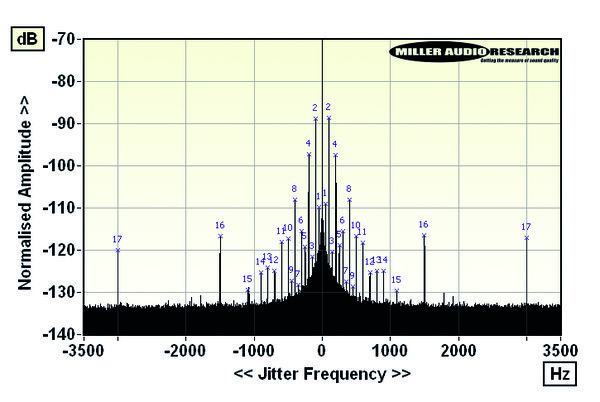McIntosh C2800 Lab Report
Although the 0dB position on Mac’s meters represents a 4.3V balanced output, the C2800 is actually capable of delivering 15.3V (analogue in/out), or 13.8V (digital in, 0dBFs) where it clips at volume ‘92%’ or higher. The 97ohm source impedance increases to 310ohm/25Hz in tune with the gentle LF roll-off of –0.2dB/20Hz and –6dB/3Hz while the top-end reaches out to –0.2dB/20kHz and –3.2dB/100kHz via the analogue in/out loop. Via the digital inputs the response is modified by McIntosh’s choice of linear phase digital filter and, of course, the incoming sample rate, resulting in –0.1dB/20kHz, –0.9dB/45kHz and –1.4dB/90kHz with 48kHz, 96kHz and 192kHz files, respectively. Analogue distortion is a very steady 0.001-0.0013% (re. 0dBV, 20Hz-20kHz) as it is via digital input(s) at 0.008-0.011% (0dBFs). Importantly, while distortion necessarily increases as the digital signal level decreases – from a minimum of 0.003-0.006% (–10dBFs) to 0.012-0.013% (–30dBFs, all 20Hz-20kHz) and upwards – it’s the consistency of this harmonic ‘colour’ with frequency [see Graph 1] that will be subjectively most pleasing.
Analogue distortion is a very steady 0.001-0.0013% (re. 0dBV, 20Hz-20kHz) as it is via digital input(s) at 0.008-0.011% (0dBFs). Importantly, while distortion necessarily increases as the digital signal level decreases - from a minimum of 0.003-0.006% (-10dBFs) to 0.012-0.013% (-30dBFs, all 20Hz-20kHz) and upwards - it's the consistency of this harmonic 'colour' with frequency [see Graph 1] that will be subjectively most pleasing. Noise is low, with a wide 94.5dB A-wtd S/N ratio (analogue in/out re. 0dBV) and 106.7dB (digital, re. 0dBFs at vol '77' or 6V balanced). Hum is low too (the unwtd residual noise is -93dBV or 22µV), however there is possibly some signal coupling via the PSU at low frequencies where the channel separation falls to 35dB/20Hz (that's 20Hz, not 20kHz) and where the jitter spectrum shows a very clear ±100Hz pattern [see Graph 2]. The latter is typically a rectifier switching mode - decades of listening experience suggests the subjective effect of this PSU-induced jitter will be entirely positive (!) and usually interpreted as a little extra weight and impact to low bass transients. PM


| Maximum Output Level / Impedance | 15.2Vrms / 97-310ohm (Xlr) |
| A-wtd S/N Ratio (USB / Preamp) | 106.7dB / 94.5dB |
| Distortion (1kHz, 0dBFs/-30dBFs) | 0.0085% / 0.0115% |
| Distortion & Noise (20kHz, 0dBFs/-30dBFs) | 0.011% / 0.0125% |
| Freq. Resp. (20Hz-20kHz/45kHz/90kHz) | +0.0 To -0.1dB/-0.9dB/-1.4dB |
| Digital Jitter (48kHz / 96kHz / 192kHz) | 2115psec/1065psec/755psec |
| Resolution (1kHz @ -100dBFs/-110dBFs) | ±0.1dB / ±0.8dB |
| Power Consumption | 46W (3W Standby) |
| Dimensions (WHD) / Weight | 445X194X419mm / 12.5kg |
| Price | £11,995 |

























































